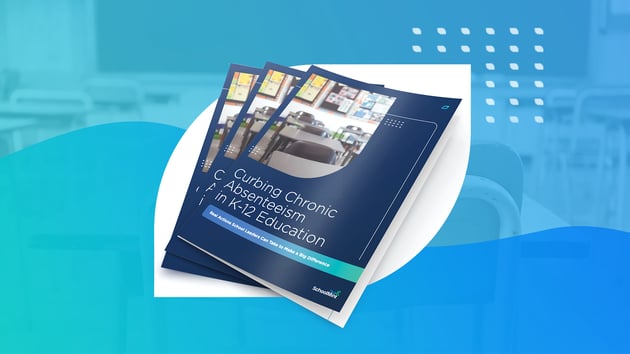Best Practices for Tardy Management in Schools
Here are four tips for reducing school tardiness and creating an effective tardy management plan.
Most K-12 schools make it a priority to get and keep tardiness under control. And tardiness problems affect more than just the front desk.
Regardless of how you sign in students who arrive late, long lines and processing times have a compounding effect on instruction time for every student. And all of this negatively affects student achievement in the long run.
An effective tardy management plan holds students accountable and encourages improvement.
Previously, you may have learned about how you can reduce chronic absenteeism. Now you’ll learn some best practices for tardy management and how you can build an effective program that reduces student tardies.
4 Tips for Tardy Management
Tardy Management Tip 1: Have a Closed-Door Policy
The first step you can take to reduce tardiness is to institute a closed-door policy. This means doors close when the bell rings. If you’re late, you’re late. And now you need to get a pass.
A closed-door policy accomplishes a few goals:
- Minimizes classroom interruptions for students who showed up on time and prepared.
- Establishes clear, consistent expectations for students.
- Keeps teachers from spending valuable instruction time reprimanding late students.
When you establish a closed-door policy, students quickly learn what is expected of them. And once you have this plan in place, you can then determine how you want to redirect tardy behavior.
Looking for more in-depth advice about tardy management and chronic absenteeism in schools? Check out our 16-page guide by clicking here or by clicking the image below.
Tardy Management Tip 2: Use Progressive Discipline
Progressive discipline is one well-established avenue for managing tardiness. With this system, you treat minor incidents first with warnings. Eventually, tardies escalate to more aggressive disciplinary actions (like detention or Saturday school).
A progressive discipline policy can work like this:
- 1st tardy: Warning
- 2nd tardy: More urgent warning
- 3rd tardy: Detention
- 4th tardy: Detention
- 5th tardy: Saturday school
Progressive discipline shows students it’s not okay to be late. And it also clearly lays out the consequences if they continue being late. However…
If you’re using progressive disciplinary to address tardiness, you need the resources to handle the detention volume these programs create.

For example, say you assign 100 student detentions per week but have only one detention period on Wednesdays.
If that detention can accommodate only 15 students, two things will happen:
- You’ll get hopelessly backed up. And you will not have space for all students.
- The punishment will mean less and less to the student as time passes between the tardy behavior and the date of detention.
Progressive discipline can be highly effective, but you must have the proper supports in place for it to work.
Tardy Management Tip 3: Use Positive Reinforcement
A positive behavior program can be highly effective at effectively reducing tardiness. But there is a caveat: the positive reinforcement must occur in the context of a positive program, one where students are engaged and care about rewards for good behavior.
Addressing tardiness behavior through positive reinforcement is simple. In periods where you have a tardiness problem (typically first period), ask your teachers to quickly reward students who show up on time and ready to learn. Again, a closed-door policy will make this process easy for the teacher.
For your positive reinforcement plan to be effective for curbing tardiness, note that you should:
- Give reinforcement immediately after the target behavior (i.e., showing up on time).
- Ensure all reinforcement is genuine and age-appropriate for the student.
When you reward or positively acknowledge individual students for displaying the behaviors you want, you encourage them to repeat that behavior.

Tardy Management Tip 4: Get Families Involved
There can be many reasons a student is tardy. And your front desk has probably heard them all.
Some reasons for tardiness are legitimate. Some don’t hold up to scrutiny. But whatever the excuse, it’s a good idea to get parents and guardians involved early in the process.
Remember, to curb chronic tardiness before it escalates into chronic absenteeism, early intervention is critical.
With a behavior management and tardy tracking platform like SchoolMint Hero, you have two ways to get families involved with tardiness:
- SchoolMint Hero can automatically create a letter or email that triggers when some action — like a second warning or detention assignment — occurs.
- You can send immediate push notifications to a parent or guardian’s Hero app whenever a disciplinary action occurs.
With either option, the system gives you the opportunity to bring the student’s family into the conversation to help find the root of the problem.
- Learn more: What Student Behavior Patterns Can Tell Us
And without you involving the parents or guardians, they may never know their child has problems at school.
Long-Term Success in Tardiness Reduction
It’s unlikely you will ever completely eliminate tardiness. But the good news about tardiness reduction programs is they tend to pay off quickly.
Our partners who use SchoolMint Hero often see tardiness reduced by 30–80% within the first few months of putting the system in place.
To maintain this success, it’s important to keep two things in mind:
You’ve got to keep doing it.
Inconsistency from week to week weakens the expectations you’re setting with your student body. And this can cause tardiness to creep back up. Curbing tardiness isn’t a one-and-done thing. It must be an ongoing, proactive process.
You’ve got to be consistent across classrooms.
As with other types of discipline programs, consistently applying your tardy behavior standards across classrooms ensures fairness and minimizes spikes when schedules change from semester to semester or year to year.
SchoolMint Hero Helps Reduce Tardiness and Improve Efficiency
To reduce the impact of tardiness, you need to reduce the processing time. Doing so lowers the impact of tardies on instruction in the classroom.
SchoolMint Hero makes this easy by automating the discipline actions resulting from tardy infractions and by giving you tools like scanners and pass printers (and mobile versions of both) to streamline the process as much as possible.
Do you have questions about how a tardiness reduction program might work at your school? Or do you want to hear about current Hero users getting great results in tardy reduction?
Get in touch about tardy behavior management with SchoolMint Hero!
Share this
You May Also Like
These Related Stories

Lake Nona Middle School: Increasing Instructional Time, Decreasing Suspensions by 80%

How to Measure Success: PBIS in Your School



